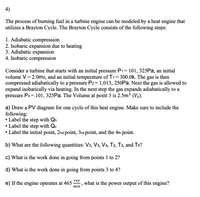
Elements Of Electromagnetics
7th Edition
ISBN: 9780190698614
Author: Sadiku, Matthew N. O.
Publisher: Oxford University Press
expand_more
expand_more
format_list_bulleted
Concept explainers
Question
Answer Questions C) D) E)

Transcribed Image Text:4)
The process of burning fuel in a turbine engine can be modeled by a heat engine that
utilizes a Brayton Cycle. The Brayton Cycle consists of the following steps:
1. Adiabatic compression
2. Isobaric expansion due to heating
3. Adiabatic expansion
4. Isobaric compression
Consider a turbine that starts with an initial pressure P1= 101, 325PA, an initial
volume V = 2.0m3, and an initial temperature of T1= 300.0k. The gas is then
compressed adiabatically to a pressure P2= 1,013, 250PA. Next the gas is allowed to
expand isobarically via heating. In the next step the gas expands adiabatically to a
pressure P4 = 101, 325Pa. The Volume at point 3 is 2.5m³ (V3).
a) Draw a PV diagram for one cycle of this heat engine. Make sure to include the
following:
• Label the step with Qh
• Label the step with Qc
• Label the initial point, 2nd point, 3rd point, and the 4th point.
b) What are the following quantities: V2, V3, V4, T2, T3, and T4?
c) What is the work done in going from points 1 to 2?
d) What is the work done in going from points 3 to 4?
rev
e) If the engine operates at 465
what is the power output of this engine?
min
Expert Solution
This question has been solved!
Explore an expertly crafted, step-by-step solution for a thorough understanding of key concepts.
This is a popular solution
Trending nowThis is a popular solution!
Step by stepSolved in 3 steps with 3 images

Knowledge Booster
Learn more about
Need a deep-dive on the concept behind this application? Look no further. Learn more about this topic, mechanical-engineering and related others by exploring similar questions and additional content below.Similar questions
- A projectile is given an initial velocity v, at an angle ø above the horizontal. The velocity of the projectile when it hits the slope is initial velocity vo- the A) less than B) equal to D) None of the above. C) greater thanarrow_forwardOnly handwritten ,draw fbdarrow_forward6 kN/m 4 kN/m 2 m 1.5 m Which of the following is closest to the magnitude of the single resultant force for the distributed loads applied the entire length of the cantilevered beam above? a) 10 kN b) 5 kN c) 17 kN d) 12.5 kNarrow_forward
arrow_back_ios
arrow_forward_ios
Recommended textbooks for you
 Elements Of ElectromagneticsMechanical EngineeringISBN:9780190698614Author:Sadiku, Matthew N. O.Publisher:Oxford University Press
Elements Of ElectromagneticsMechanical EngineeringISBN:9780190698614Author:Sadiku, Matthew N. O.Publisher:Oxford University Press Mechanics of Materials (10th Edition)Mechanical EngineeringISBN:9780134319650Author:Russell C. HibbelerPublisher:PEARSON
Mechanics of Materials (10th Edition)Mechanical EngineeringISBN:9780134319650Author:Russell C. HibbelerPublisher:PEARSON Thermodynamics: An Engineering ApproachMechanical EngineeringISBN:9781259822674Author:Yunus A. Cengel Dr., Michael A. BolesPublisher:McGraw-Hill Education
Thermodynamics: An Engineering ApproachMechanical EngineeringISBN:9781259822674Author:Yunus A. Cengel Dr., Michael A. BolesPublisher:McGraw-Hill Education Control Systems EngineeringMechanical EngineeringISBN:9781118170519Author:Norman S. NisePublisher:WILEY
Control Systems EngineeringMechanical EngineeringISBN:9781118170519Author:Norman S. NisePublisher:WILEY Mechanics of Materials (MindTap Course List)Mechanical EngineeringISBN:9781337093347Author:Barry J. Goodno, James M. GerePublisher:Cengage Learning
Mechanics of Materials (MindTap Course List)Mechanical EngineeringISBN:9781337093347Author:Barry J. Goodno, James M. GerePublisher:Cengage Learning Engineering Mechanics: StaticsMechanical EngineeringISBN:9781118807330Author:James L. Meriam, L. G. Kraige, J. N. BoltonPublisher:WILEY
Engineering Mechanics: StaticsMechanical EngineeringISBN:9781118807330Author:James L. Meriam, L. G. Kraige, J. N. BoltonPublisher:WILEY

Elements Of Electromagnetics
Mechanical Engineering
ISBN:9780190698614
Author:Sadiku, Matthew N. O.
Publisher:Oxford University Press

Mechanics of Materials (10th Edition)
Mechanical Engineering
ISBN:9780134319650
Author:Russell C. Hibbeler
Publisher:PEARSON

Thermodynamics: An Engineering Approach
Mechanical Engineering
ISBN:9781259822674
Author:Yunus A. Cengel Dr., Michael A. Boles
Publisher:McGraw-Hill Education

Control Systems Engineering
Mechanical Engineering
ISBN:9781118170519
Author:Norman S. Nise
Publisher:WILEY

Mechanics of Materials (MindTap Course List)
Mechanical Engineering
ISBN:9781337093347
Author:Barry J. Goodno, James M. Gere
Publisher:Cengage Learning

Engineering Mechanics: Statics
Mechanical Engineering
ISBN:9781118807330
Author:James L. Meriam, L. G. Kraige, J. N. Bolton
Publisher:WILEY